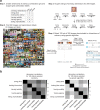Disentangling five dimensions of animacy in human brain and behaviour
- PMID: 36376446
- PMCID: PMC9663603
- DOI: 10.1038/s42003-022-04194-y
Disentangling five dimensions of animacy in human brain and behaviour
Abstract
Distinguishing animate from inanimate things is of great behavioural importance. Despite distinct brain and behavioural responses to animate and inanimate things, it remains unclear which object properties drive these responses. Here, we investigate the importance of five object dimensions related to animacy ("being alive", "looking like an animal", "having agency", "having mobility", and "being unpredictable") in brain (fMRI, EEG) and behaviour (property and similarity judgements) of 19 participants. We used a stimulus set of 128 images, optimized by a genetic algorithm to disentangle these five dimensions. The five dimensions explained much variance in the similarity judgments. Each dimension explained significant variance in the brain representations (except, surprisingly, "being alive"), however, to a lesser extent than in behaviour. Different brain regions sensitive to animacy may represent distinct dimensions, either as accessible perceptual stepping stones toward detecting whether something is alive or because they are of behavioural importance in their own right.
© 2022. The Author(s).
Conflict of interest statement
The authors declare no competing interests.
Figures







References
-
- Funnell E, Sheridan J. Categories of knowledge? unfamiliar aspects of living and nonliving things. Cogn. Neuropsychol. 2007;9:135–153. doi: 10.1080/02643299208252056. - DOI
-
- Ralph MAL, Howard D, Nightingale G, Ellis AW. Are living and non-living category-specific deficits causally linked to impaired perceptual or associative knowledge? Evidence from a category-specific double dissociation. Neurocase. 1998;4:311–338. doi: 10.1080/13554799808410630. - DOI
Publication types
MeSH terms
Grants and funding
LinkOut - more resources
Full Text Sources

